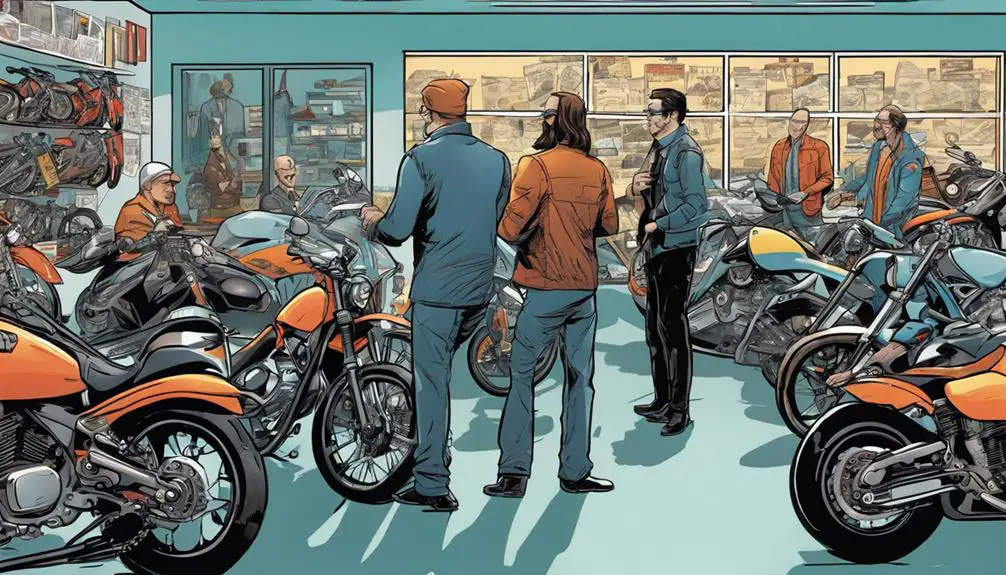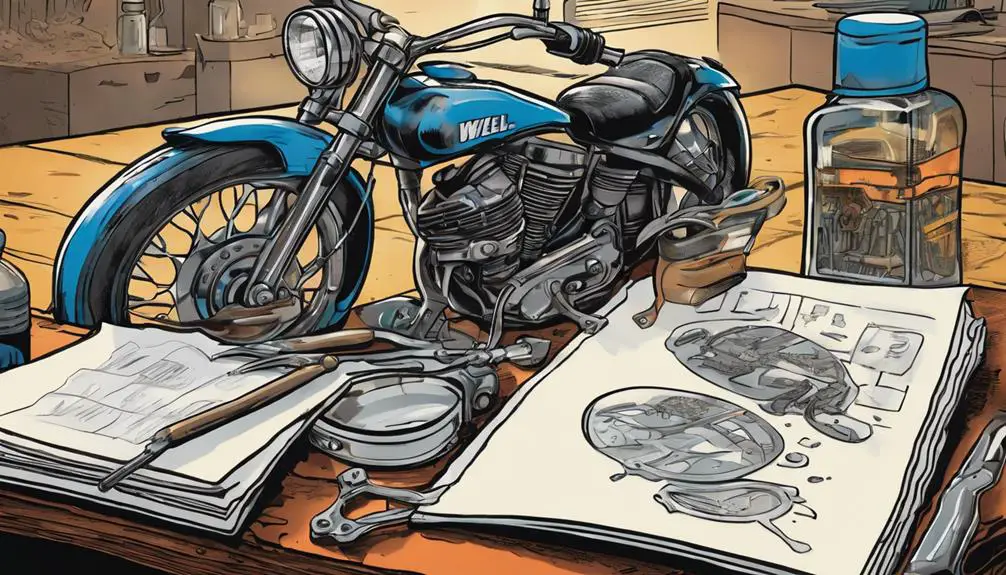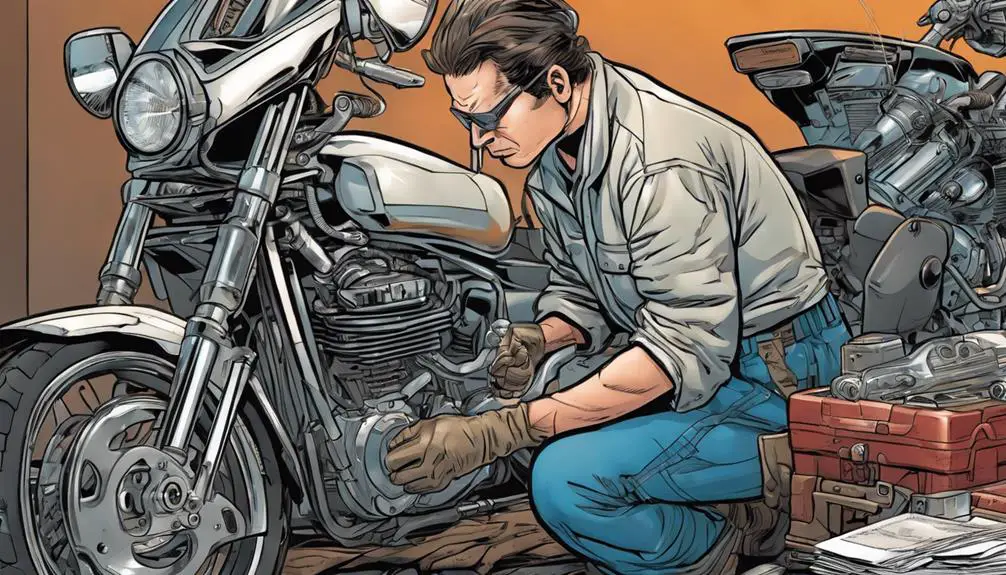When it comes to maneuvering motorcycle warranty challenges, you may find yourself facing a maze of terms and conditions that can feel overwhelming. It is crucial to understand your warranty inside and out, as well as to keep thorough documentation of all service and issues. By establishing clear communication with your dealer and knowing your rights, you can make the process smoother. But what about those common problems that could catch you off guard? Let's explore how to tackle these challenges effectively, ensuring your investment remains protected.
Key Takeaways
- Familiarize yourself with warranty terms, including coverage specifics and duration, to avoid surprises later on.
- Keep detailed records of motorcycle issues and maintenance to support your warranty claims.
- Communicate clearly and openly with your dealer to build trust and ensure effective service.
- Document all dealer interactions, including dates and details, to create a reliable reference for disputes.
Understand Your Warranty Terms

To make the most of your motorcycle warranty, you need to clearly understand its terms and conditions. Explore the fine print and familiarize yourself with the coverage specifics. Know what parts and services are included, and which ones are excluded. This knowledge is power; it keeps you in control of your ride and your resources.
Pay attention to the duration of the warranty and the mileage limits. Some warranties may only cover you for a specific period or until you hit a certain number of miles. Being aware of these limits can save you from unpleasant surprises down the road.
Additionally, check for any requirements that could affect your warranty status. Regular maintenance might be a must to keep your warranty valid, so don't overlook that.
Document All Issues
Keeping a detailed record of any issues that arise with your motorcycle can greatly enhance your warranty experience. When you document problems, you create a clear history that supports your claims. This isn't just about jotting down notes; it's about empowering yourself. Every scratch, every weird noise, and every malfunction matters. Write down dates and specifics, and don't forget to include the mileage.
Photographs can be invaluable, too. They provide visual proof of any damage or unusual wear, solidifying your case if disputes arise later. If you've had any repairs done, keep receipts and any correspondence with mechanics or dealers. This isn't just paperwork; it's your shield against frustration.
You're not just a rider; you're an advocate for your own freedom on the road. By meticulously documenting each issue, you're reclaiming control over your motorcycle experience. This proactive approach not only helps in warranty claims but also cultivates a deeper understanding of your bike.
You deserve a hassle-free riding experience, and thorough documentation is an essential step in achieving that liberation. So, grab a notebook or use an app, and start documenting today!
Communicate With Dealers

When you communicate with dealers, building strong relationships is key.
Be clear and concise about your needs and concerns to avoid misunderstandings.
Don't forget to document all interactions, as this can help you if issues arise later on.
Build Strong Relationships
Building a strong relationship with your dealer can greatly enhance your motorcycle ownership experience. When you connect with your dealer, you're not just another customer; you become a valued partner in the journey of your ride. Share your motorcycle dreams and adventures with them. Let them know what you love about your bike and what you hope to achieve on the open road.
Don't hesitate to ask questions, seek advice, and express any concerns. A good dealer will appreciate your openness and respond with genuine interest. Regular visits for maintenance, even just to chat, can foster trust and loyalty. This connection can lead to better service, exclusive deals, and valuable insights into your motorcycle's needs.
If any warranty issues arise, having a strong rapport can make a world of difference. Your dealer will be more inclined to advocate for you, understanding your history and commitment to your bike. Remember, it's about more than just transactions; it's about building a community.
Be Clear and Concise
Clear and concise communication with your dealer guarantees that both of you are on the same page regarding your motorcycle's needs and any warranty concerns.
When discussing issues, get straight to the point. Clearly outline the problem you're facing, and avoid unnecessary jargon that might confuse the conversation. This will help your dealer understand your situation better and offer effective solutions.
Be honest about your expectations. If you want a quick resolution or specific repairs, let them know upfront. Don't hesitate to ask questions if something isn't clear. This isn't just about your bike; it's about your freedom on the road. You deserve to feel empowered in these discussions.
When you communicate clearly, it builds trust and sets the stage for a productive relationship. Remember, your dealer is there to help you, but they can only do so if you provide them with the right information.
Keep it simple, direct, and focused. This approach not only saves time but also guarantees that your motorcycle gets the care it needs, allowing you to ride freely and confidently.
Document All Interactions
To guarantee you have a reliable record of your motorcycle's warranty interactions, document every conversation you have with your dealer. Keep a dedicated notebook or digital file where you jot down dates, names, and details of each discussion. This isn't just about being organized; it's your shield against potential disputes.
When you engage with your dealer, be sure to address specific concerns and ask questions that matter to you. Make note of their responses, and don't hesitate to request clarification if something seems off. If a dealer promises a follow-up or a specific action, write that down, too. This record empowers you, ensuring you have the facts straight if issues arise later.
If you communicate via email or text, save those messages. They can serve as critical evidence if you need to escalate your concerns. Remember, you're not just a customer; you're a force to be reckoned with, and your documentation backs that up.
When it comes to warranties, knowledge is power, and being thorough in your documentation helps you reclaim control over your motorcycle experience. Stand firm, and don't let challenges deter you from enjoying your ride!
Research Common Ducati Problems
When you own a Ducati, it's vital to stay informed about common issues that may arise.
Many riders face frequent electrical problems, engine performance concerns, and brake system anomalies.
Frequent Electrical Issues
Ducati owners often encounter electrical issues, with problems like faulty wiring and battery drainage being among the most common complaints. These issues can leave you feeling stranded, turning your ride into a headache instead of a thrill.
One frequent culprit is the wiring harness; it might fray or get pinched, causing shorts that disrupt your bike's performance. Regularly inspect the wiring for signs of wear and tear.
Another common problem is battery drainage, often linked to the bike's charging system. If you notice your battery dying quickly, consider checking the voltage regulator and rectifier. Sometimes, it's just a loose connection, but it's essential to address it before it ruins your ride.
Don't forget to check your fuses, as blown fuses can lead to unexpected electrical failures. If you're unsure about diagnosing these issues, consult your dealer or a trusted mechanic who knows Ducatis inside and out.
Engine Performance Concerns
Have you noticed any unusual sounds or a drop in power during your rides? These engine performance concerns can be frustrating, especially if you're looking to feel that exhilarating freedom on the open road.
Ducati motorcycles, while renowned for their power and style, aren't without their quirks. Common issues include rough idling, excessive vibrations, and unexpected engine stalls.
If your bike's performance feels off, it might be time to dig deeper. Check the fuel system, as dirty injectors or a clogged filter can steal your bike's power. Additionally, listen for rattling or knocking sounds; these could signal serious internal issues, such as a failing cam chain tensioner, a known problem in some Ducati models.
Before you hit the road again, verify your engine's oil is fresh and at the right level, as poor lubrication can lead to performance drops.
If you're still experiencing problems, document your observations and take your bike to an authorized dealer. Remember, you deserve a motorcycle that delivers the thrill you crave, so don't hesitate to address these engine concerns head-on!
Brake System Anomalies
Brake system anomalies can sneak up on you, impacting your safety and ride quality if not addressed promptly. For Ducati riders, these issues often manifest as inconsistent braking performance, spongy brake levers, or unusual noises when applying the brakes. If you notice any of these symptoms, don't ignore them. They could indicate problems like air in the brake lines or worn-out components.
It's essential to regularly inspect your brake system, checking for fluid leaks and ensuring the brake pads are in good condition. If you find yourself in a situation where the brakes are underperforming, know that you have options under your warranty. Document any anomalies you encounter, and don't hesitate to take your bike to an authorized dealer for a thorough examination.
Ducati warranties typically cover brake system defects, so you shouldn't feel restrained when seeking repairs. Remember, your freedom on the road depends on a reliable braking system. By staying proactive and informed, you can confidently navigate any warranty challenges that arise from brake system anomalies, ensuring your ride remains as liberating as it was meant to be.
Keep Maintenance Records

Keeping detailed maintenance records not only helps you stay organized but also strengthens your warranty claims when needed. Every time you change the oil, check the brakes, or perform any other maintenance, jot it down. This simple act can be the difference between a smooth claim process and an uphill battle.
You might think it's a hassle, but trust me, it's worth it. When you document each service, you create a powerful narrative that shows you've cared for your bike. It's proof that you've followed the manufacturer's guidelines, which can be essential if you ever need to assert a warranty claim.
Use a dedicated notebook, a digital app, or even an Excel spreadsheet—whatever works for you. Just make sure to include dates, service types, and any parts replaced. If you've worked with a mechanic, keep receipts and notes from those visits.
With these records in hand, you can confidently navigate any warranty discussions, knowing you've done your part. Embrace the freedom that comes from being prepared; it empowers you to ride without worry. So gear up, keep those records, and ride on!
Know Your Rights
Understanding your rights as a motorcycle owner is essential, especially when it comes to warranty claims and potential disputes.
You've invested your hard-earned money into your bike, and it's vital to know what protections you have under the warranty. Familiarizing yourself with your rights can empower you to stand your ground when facing challenges.
Here are a few key rights every motorcycle owner should know:
- Express Warranty: You have the right to a remedy if your motorcycle doesn't meet the terms outlined in the warranty.
- Implied Warranty: Even if it's not stated, the law often assumes that your motorcycle should be fit for use and free from defects.
Seek Expert Advice

Seeking expert advice can make a significant difference when maneuvering the complexities of motorcycle warranties. You don't have to face this journey alone; tapping into the knowledge of professionals can empower you to make informed decisions.
Whether it's a seasoned mechanic or a warranty specialist, these experts can offer insights that save you time and money.
Consider connecting with a motorcycle community or forum. Fellow riders often share experiences and recommendations about reliable experts. This peer support can be invaluable in finding someone who's well-versed in warranty issues specific to your bike model.
Don't hesitate to consult a legal expert if you find yourself in a dispute. They can clarify your rights and help you navigate any tricky situations.
Frequently Asked Questions
How Does the Warranty Transfer if I Sell My Motorcycle?
When you sell your motorcycle, the warranty often transfers to the new owner, but it depends on the manufacturer's policies.
Check your warranty documents to see if transfer is allowed and if any fees apply.
You'll want to inform the buyer about the remaining coverage.
Make sure you handle the paperwork correctly, so both you and the new owner can enjoy peace of mind, knowing the bike's still under warranty for a while.
Can I Modify My Motorcycle Without Voiding the Warranty?
Did you know that nearly 70% of motorcycle owners modify their bikes?
If you're thinking about customizing yours, be careful. Modifications can potentially void your warranty.
Manufacturers often specify that alterations could lead to warranty issues, especially if they affect performance or safety.
To keep your warranty intact, check with your dealer before making changes.
Freedom in riding shouldn't come at the cost of losing your warranty protection!
What Should I Do if My Warranty Claim Is Denied?
If your warranty claim's denied, don't lose hope.
Start by reviewing the denial letter to understand their reasons.
Gather any supporting documents and evidence that back up your claim.
Contact the warranty provider to discuss your situation and express your concerns.
If necessary, escalate the issue to a supervisor.
You might also consider seeking legal advice or filing a complaint with relevant consumer protection agencies.
Stay persistent, and fight for what you deserve!
Are Aftermarket Parts Covered Under the Warranty?
When you customize your ride, it's like adding your own flair to a canvas.
However, aftermarket parts often aren't covered under your warranty.
Think of it this way: if you paint a masterpiece over a piece of art, the original artist mightn't honor repairs.
Manufacturers usually void warranties if non-original parts cause issues.
How Long Does the Warranty Last for My Motorcycle Model?
To find out how long the warranty lasts for your motorcycle model, check your owner's manual or the manufacturer's website.
Most warranties cover a specific period, often between one to two years, or a certain mileage, whichever comes first.
If you bought your bike used, you might want to contact the dealer for details.
Staying informed about your warranty guarantees you can take full advantage of the coverage and enjoy your ride worry-free.
Conclusion
Steering through motorcycle warranty challenges might feel like riding through a storm, but with these tips, you can steer clear of pitfalls.
By understanding your warranty terms and keeping thorough records, you're equipping yourself like a knight with a trusty sword against warranty dragons.
Remember, communication is key, and knowing your rights guarantees you're not left in the dark.
So, take charge of your journey, and don't hesitate to seek help when the road gets bumpy.